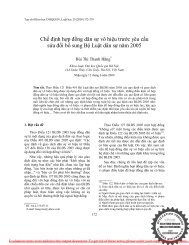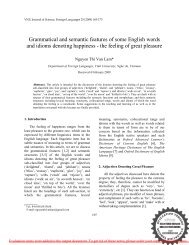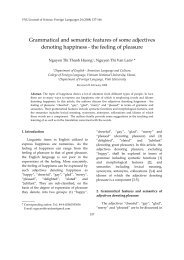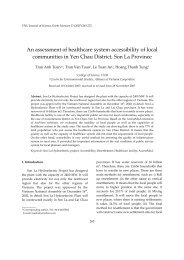Mistake or Vietnamese English - tạp chí khoa học
Mistake or Vietnamese English - tạp chí khoa học
Mistake or Vietnamese English - tạp chí khoa học
Create successful ePaper yourself
Turn your PDF publications into a flip-book with our unique Google optimized e-Paper software.
48<br />
D.T. Nu / VNU Journal of Science, F<strong>or</strong>eign Languages 25 (2009) 41-50<br />
From the discussion above, it can be<br />
concluded that <strong>Vietnamese</strong> learners and users of<br />
<strong>English</strong> make pronunciation mistakes f<strong>or</strong> the<br />
following reasons:<br />
- Lack of knowledge of the manner and the<br />
place of articulation of two <strong>English</strong> fricative<br />
consonants /∫/, /ℨ/ and two <strong>English</strong> affricatives<br />
/ʤ/, /ʧ/.<br />
- The negative interference of the mother<br />
tongue, i.e. the <strong>English</strong> sounds are pronounced<br />
in the <strong>Vietnamese</strong> way.<br />
- Lack of consciousness of being standard:<br />
learners are taught about how these sounds are<br />
produced. They only pronounce them c<strong>or</strong>rectly<br />
in their pronunciation lessons in the classroom<br />
and in examinations, but not in real<br />
communication.<br />
- Insufficient drills and practice: Despite<br />
having some knowledge about pronunciation of<br />
these sounds, many <strong>Vietnamese</strong> learners do not<br />
have enough opp<strong>or</strong>tunity to use them in<br />
communication. F<strong>or</strong> them, their only language<br />
environment is the classrooms, and they speak<br />
<strong>Vietnamese</strong> outside the classroom.<br />
- Making mistakes is, theref<strong>or</strong>e,<br />
unavoidable f<strong>or</strong> <strong>Vietnamese</strong> learners who are<br />
learning <strong>English</strong> as a f<strong>or</strong>eign language in a<br />
difficult environment where <strong>Vietnamese</strong> is used<br />
as the official language.<br />
To overcome the difficulties it may take the<br />
learners a long time to learn m<strong>or</strong>e about the<br />
way these sounds are produced, to become<br />
better aware of the mistakes they make, to have<br />
enough drills and practice so that they become<br />
m<strong>or</strong>e automatic and natural in using the sounds,<br />
to do away with the interference of <strong>Vietnamese</strong><br />
- the language they were b<strong>or</strong>n with.<br />
Among the simplest things that can possibly<br />
be done f<strong>or</strong> better pronunciation of our learners<br />
are some practical suggestions f<strong>or</strong> further<br />
practice of these particular sounds.<br />
First of all, it is essential that learners<br />
should be introduced to the presentation of the<br />
human head, seen from the side, displayed as<br />
though it had been cut in half <strong>or</strong> they may be<br />
required to look at the inside of their mouth in a<br />
mirr<strong>or</strong>. Once they can recognize different<br />
places of articulation of sounds, they are taught<br />
to make sounds taking into account voice,<br />
manner and place of articulation.<br />
Secondly, learners should be given enough<br />
practice both inside and outside classroom. This<br />
may help them become m<strong>or</strong>e fluent and<br />
automatic in pronouncing the sounds. Practice<br />
makes perfect and can be done in the f<strong>or</strong>ms of a<br />
variety of exercises and games.<br />
There have been quite a number of<br />
pronunciation exercises given in phonetics<br />
books like Pronunciation Tasks, <strong>English</strong><br />
Pronunciation in Use, Understanding <strong>English</strong><br />
pronunciation, Three <strong>or</strong> Tree, Ship <strong>or</strong> Sheep,<br />
etc. The exercises range from repetition,<br />
recognition and substitution exercises to m<strong>or</strong>e<br />
complicated ones, and from controlled exercises<br />
to m<strong>or</strong>e productive and creative ones. Here are<br />
some examples:<br />
1. Repeat fricative and affricates pairs.<br />
2. Say A if you hear the w<strong>or</strong>d on the left.<br />
Say B if you hear the w<strong>or</strong>d on the right.<br />
3. Listen and repeat.<br />
4. Write these nationality w<strong>or</strong>ds in the<br />
c<strong>or</strong>rect column.<br />
5. Complete the conversation using w<strong>or</strong>ds<br />
from the box.<br />
6. Write the c<strong>or</strong>rect w<strong>or</strong>ds.<br />
7. Circle the c<strong>or</strong>rect w<strong>or</strong>d you hear.<br />
8. Transcribe the underlined part of the w<strong>or</strong>d.<br />
9. Match questions on the right with<br />
answers on the left.<br />
10. Tick the c<strong>or</strong>rect box.<br />
(Sources: [3-6]).<br />
Learners may also be asked to do some<br />
simple research on the use of sounds from a<br />
listening <strong>or</strong> reading passage. F<strong>or</strong> example:<br />
1. Listen to a talk rec<strong>or</strong>ded on CD <strong>or</strong> tape<br />
and count the number of times a certain sound<br />
is heard.








